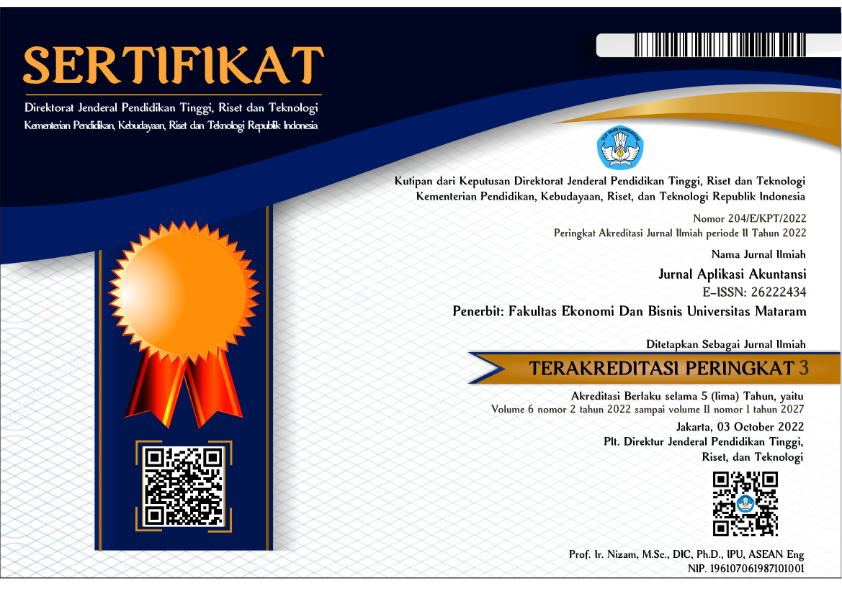CASA, NIM, dan Profitabilitas Perbankan di Indonesia
DOI:
https://doi.org/10.29303/jaa.v5i1.90Keywords:
CASA, NIM, profitability, bankingAbstract
ABSTRACT
This study aims to increase the role of CASA and NIM in improving the profitability of banks in Indonesia. This research was motivated by various CASA improvement strategies undertaken by banks to maximize profits, as well as OJK policies to support NIM to improve the efficiency and competitiveness of Indonesian banks. On the other hand, this research is also supported by the limited research that analyzes the relationship of CASA with banking profitability. The hypothesis in this study discusses using multiple linear regression. BEI in 2016-2018, this study proves that CASA and NIM are proven to increase bank profitability. These results prove that the proportion of CASA owned by banks can reduce the cost of funds resulting in increased profitability. This study also proves the ability of banks to generate profits from interest can support increased bank profitability. Additional analysis shows that CASA can increase NIM. Furthermore, NIM has also been proven to mediate CASA's relationship with banking profitability.
Keywords: CASA, NIM, profitability, banking
ABSTRAK
Penelitian ini bertujuan untuk mengidentifikasi peran CASA dan NIM pada peningkatan profitabilitas perbankan di Indonesia. Penelitian ini dimotivasi oleh berbagai strategi peningkatan CASA yang dilakukan perbankan untuk memaksimalkan profit, serta kebijakan OJK untuk menekan NIM guna meningkatkan efisiensi dan daya saing perbankan Indonesia. Di sisi lain, penelitian ini juga didorong oleh masih terbatasnya penelitian yang menganalisis hubungan CASA dengan profitabilitas perbankan. Hipotesis dalam penelitian ini diuji dengan menggunakan regresi linier berganda. Dengan melakukan pengamatan pada perbankan yang menerbitkan sahamnya di BEI pada tahun 2016-2018, penelitian ini menunjukkan bahwa CASA dan NIM terbukti meningkatkan profitabilitas perbankan. Hasil ini membuktikan bahwa proporsi CASA yang dimiliki perbankan dapat menurunkan biaya dana sehingga terjadi kenaikan profitabilitas. Penelitian ini juga membuktikan bahwa kemampuan perbankan dalam menghasilkan laba dari bunga dapat mendorong kenaikan profitabilitas perbankan. Analisis tambahan menunjukkan bahwa CASA dapat meningkatkan NIM. Selanjutnya, NIM juga terbukti memediasi hubungan CASA dengan profitabilitas perbankan.
Kata kunci: CASA, NIM, profitabilitas, perbankan
References
Adelopo, I., Lloydking, R., & Tauringana, V. (2018). Determinants of bank profitability before , during , and after the financial crisis. International Journal of Managerial Finance, 14(4), 378–398. https://doi.org/10.1108/IJMF-07-2017-0148
Albertazzi, U., & Gambacorta, L. (2010). Bank profitability and taxation. Journal of Banking and Finance, 34(11), 2801–2810. https://doi.org/10.1016/j.jbankfin.2010.06.00
Ali, M., & Puah, C.H. (2018). The internal determinants of bank profitability and stability An insight from banking sector of Pakistan. Management Research Review, 42(1), 49–67. https://doi.org/10.1108/MRR-04-2017-0103
Assaf, A. G., Berger, A. N., Roman, R.A., & Tsionas, M. G. (2019). Does efficiency help banks survive and thrive during financial crises ? Journal of Banking and Finance, 106, 445–470. https://doi.org/10.1016/j.jbankfin.2019.07.013
Bansal, R., Singh, A., Kumar, S., & Gupta, Rajni. (2018). Evaluating factors of profitability for Indian banking sector : a panel regression. Asian Journal of Accounting Research, 3(2), 236–254. https://doi.org/10.1108/AJAR-08-2018-0026
Daly, S., & Frikha, M. (2017). Determinants of bank Performance : Comparative Study Between Conventional and Islamic Banking in Bahrain. Journal of the Knowledge Economy, 8, 471–488. https://doi.org/10.1007/s13132-015-0261-8
Dewi, I. L., & Triaryati, N. (2017). Pengaruh Faktor Internal dan Eksternal Bank terhadap Net Interest Margin di Indonesia. E-Journal Manajemen Unud, 6(6), 3051–3079.
Doyran, M. A. (2013). Net interest margins and firm performance in developing countries Evidence from Argentine commercial banks. Management Research Review, 36(7), 720–742. https://doi.org/10.1108/MRR-05-2012-0100
Fidanoski, F., Choudhry, M., Davidovic, M., & Sergi, B. S. (2018). What does affect profitability of banks in Croatia ? Competitiveness Review: An International Business Journal, 28(4), 338–367. https://doi.org/10.1108/CR-09-2016-0058
Ghozali, I. (2016). Aplikasi Analisis Multivariate dengan Program IBM SPSS 21 Edisi 8. Semarang: Badan Penerbit Universitas Diponegoro.
Hanif, M., Tariq, M., & Tahir, A. & Momeneen. Wajeeh-ul. (2012). Comparative Performance Study of Conventional and Islamic Banking in Pakistan. International Research Journal of Finance & Economics, (83).
Harun, U. (2016). Pengaruh ratio-ratio keuangan CAR, LDR, NIM, BOPO, NPL terhadap ROA. Jurnal Riset Bisnis Dan Manajemen, 4(1), 67–82.
Hasan, Mohammad Sofie A., Manurung, Adler H., & Usman, B. (2020). Determinants of Bank Profitability with Size as Moderating Variable. Journal of Applied Finance & Banking, 10(1), 153–166.
Nguyen, T. V. H., Pham, T. T. T., Nguyen, C. P., Nguyen, T. C., & Nguyen, B. T. (2020). Excess liquidity and net interest margins: Evidence from Vietnamese banks. Journal of Economics and Business, 105893.
İslatince, N. (2015). Analysis of the Factors that Determine the Profitability of the Deposit Banks in Turkey. Journal of Applied Finance & Banking, 5(3), 175–186.
Milhem, Maysa’a M., & Abadeh, I. A. A. (2018). The Impact of Macroeconomic Variables on Banks profitability and Liquidity : An Empirical Study on Islamic and Conventional banks in Jordan. Journal of Economic & Management Perspectives, 12(2), 306–318.
Muljawan, D., Hafidz, J., Astuti, Rieska I., & Oktapiani, R. (2014). Faktor-faktor Penentu Efisiensi Perbankan Indonesia serta Dampaknya terhadap Perhitungan Suku Bunga Kredit.
OJK. (2016). Siaran Pers-34/DKNS/OJK/4/2016: OJK keluarkan insentif untuk perbankan dorong penurunan suku bunga kredit.
Peng, J., Jeng, V., Wang, J. L., & Chen, Y. (2017). The impact of bancassurance on efficiency and profitability of banks : Evidence from the banking industry in Taiwan R. Journal of Banking and Finance, 80, 1–13. https://doi.org/10.1016/j.jbankfin.2017.03.013
Platonova, E., Asutay, M., Dixon, R., & Mohammad, S. (2018). The Impact of Corporate Social Responsibility Disclosure on Financial Performance : Evidence from the GCC Islamic Banking Sector. Journal of Business Ethics, 151(2), 451–471. https://doi.org/10.1007/s10551-016-3229-0
Saona, P. (2016). Intra- and extra-bank determinants of Latin American Banks ’ profitability. International Review of Economics and Finance, 45, 197–214. https://doi.org/10.1016/j.iref.2016.06.004
Sayari, K., & Shamki, D. (2016). Commercial Banks Profitability and Stock Market Developments. Journal of Applied Finance & Banking, 6(4), 43–52.
Shamki, D., Alulis, I. K., & Sayari, K. (2016). Financial Information Influencing Commercial Banks Profitability. International Journal of Economics and Finance, 8(6), 166–174. https://doi.org/10.5539/ijef.v8n6p166
Supriyono, R. A., & Herdhayinta, H. (2019). Determinants of Bank Profitability: The case of the regional development bank (BPD Bank) in Indonesia. Journal of Indonesian Economy and Business, 34(1), 1–15.
Tarus, D. K., Chekol, Y. B., & Mutwol, M. (2012). Determinants of net interest margins of commercial banks in Kenya: A panel study. Procedia Economics and Finance, 2, 199-208.
Thiagarajan, S. (2018). An Analysis of Performance of Commercial Banks in Belize during Post Global Recession Period. Journal of Finance and Bank Management, 6(2), 33–47. https://doi.org/10.15640/jfbm.v6n2a3
Tarus, D. K., Chekol, Y. B., & Mutwol, M. (2012). Determinants of net interest margins of commercial banks in Kenya: A panel study. Procedia Economics and Finance, 2, 199-208.
Yao, H., Haris, M., & Tariq, G. (2018). Profitability Determinants of Financial Institutions : Evidence from Banks in Pakistan. International Journal of Financial Studies, 6(53), 1–29. https://doi.org/10.3390/ijfs6020053









